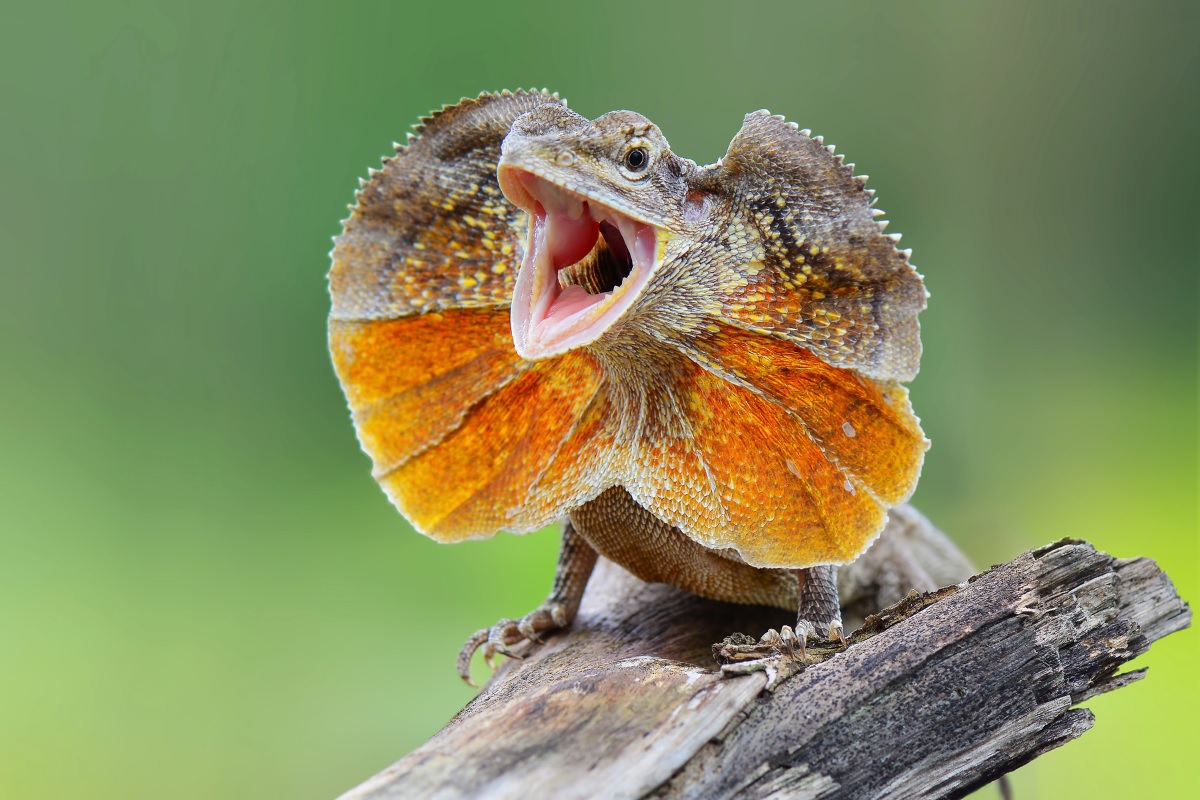
Frilled lizards are some of the most intriguing reptiles on the planet. Known for their dramatic neck frill, these creatures have captivated the curiosity of many. But what makes them so special? Frilled lizards can run on two legs, making them look like tiny dinosaurs. Their frill isn't just for show; it helps them appear larger to predators. Found mainly in Australia and New Guinea, these reptiles thrive in warm climates. They spend most of their time in trees, only coming down to hunt or escape danger. Want to know more? Here are 26 fascinating facts about these unique lizards!
Key Takeaways:
- Frilled lizards, known for their distinctive frills and arboreal lifestyle, are fascinating reptiles native to Australia and New Guinea. They are omnivores, territorial, and have unique adaptations for survival.
- While frilled lizards are not endangered, habitat destruction and climate change pose potential threats to their populations. They are admired in Aboriginal cultures, studied by scientists, and can be found in wildlife parks and zoos.
Frilled Lizard Basics
Frilled lizards, also known as frill-necked lizards, are fascinating reptiles native to Australia and New Guinea. Their unique appearance and behaviors make them a subject of interest for many. Let's dive into some intriguing facts about these remarkable creatures.
-
Scientific Name: The scientific name of the frilled lizard is Chlamydosaurus kingii.
-
Distinctive Frill: These lizards are famous for the large frill around their neck, which they can expand when threatened.
-
Size: Adult frilled lizards can grow up to 3 feet in length, including their tail.
-
Coloration: Their body color ranges from brown to gray, helping them blend into their environment.
Habitat and Distribution
Understanding where frilled lizards live and how they adapt to their surroundings provides insight into their survival strategies.
-
Native Regions: Frilled lizards are primarily found in northern Australia and southern New Guinea.
-
Preferred Habitat: They thrive in tropical and warm temperate forests, woodlands, and savannas.
-
Arboreal Lifestyle: These lizards spend most of their time in trees, descending only to hunt or escape predators.
-
Territorial Creatures: Frilled lizards are territorial and will defend their space from intruders.
Behavior and Diet
The behavior and diet of frilled lizards reveal much about their daily lives and survival tactics.
-
Diet: They are omnivores, eating insects, spiders, small mammals, and occasionally plants.
-
Hunting Style: Frilled lizards are ambush predators, waiting patiently for prey to come close before striking.
-
Frill Display: When threatened, they open their frill, hiss, and stand on their hind legs to appear larger and more intimidating.
-
Speedy Escape: If the frill display fails, they can run quickly on their hind legs to escape danger.
Reproduction and Lifespan
Reproduction and lifespan are crucial aspects of any species' biology. Here's how frilled lizards manage these aspects.
-
Breeding Season: The breeding season occurs during the wet season, from November to March.
-
Egg Laying: Females lay between 8 to 23 eggs in a burrow dug in the ground.
-
Incubation Period: The eggs incubate for about 2 to 3 months before hatching.
-
Lifespan: In the wild, frilled lizards can live up to 10 years, though they may live longer in captivity.
Unique Adaptations
Frilled lizards have developed several unique adaptations that help them survive in their natural habitat.
-
Thermoregulation: They bask in the sun to regulate their body temperature, often seen on tree branches.
-
Camouflage: Their coloration provides excellent camouflage against predators and while hunting.
-
Frill Function: Besides intimidation, the frill may help regulate body temperature and communicate with other lizards.
-
Climbing Skills: Their strong limbs and claws make them adept climbers, essential for their arboreal lifestyle.
Interaction with Humans
Frilled lizards have a unique relationship with humans, from being admired to studied for their behaviors.
-
Cultural Significance: In some Aboriginal cultures, frilled lizards are featured in stories and art.
-
Pet Trade: They are sometimes kept as exotic pets, though they require specific care and habitat conditions.
-
Research Subjects: Scientists study them to understand more about reptilian behavior and physiology.
-
Tourist Attraction: Their unique appearance makes them a popular attraction in wildlife parks and zoos.
Conservation Status
The conservation status of frilled lizards is an important aspect of their existence, reflecting their interaction with the environment and human activities.
-
IUCN Status: Currently, frilled lizards are not considered endangered and are listed as Least Concern by the IUCN.
-
Threats: Habitat destruction and climate change pose potential threats to their populations in the wild.
Fascinating World of Frilled Lizards
Frilled lizards are truly captivating creatures. Their unique frills, which they use for defense, make them stand out in the animal kingdom. These reptiles, native to Australia and New Guinea, can grow up to 3 feet long. They spend most of their time in trees, only coming down to hunt or escape predators. When threatened, they display their frills and hiss to scare off enemies. Surprisingly, they can also run on two legs, making them look like tiny dinosaurs.
Their diet mainly consists of insects, spiders, and small mammals. Frilled lizards are not just fascinating to watch; they play a crucial role in their ecosystem by controlling insect populations. Understanding these creatures helps us appreciate the diversity of life on our planet. Next time you see a frilled lizard, remember these amazing facts and share them with others.
Frequently Asked Questions
Was this page helpful?
Our commitment to delivering trustworthy and engaging content is at the heart of what we do. Each fact on our site is contributed by real users like you, bringing a wealth of diverse insights and information. To ensure the highest standards of accuracy and reliability, our dedicated editors meticulously review each submission. This process guarantees that the facts we share are not only fascinating but also credible. Trust in our commitment to quality and authenticity as you explore and learn with us.
